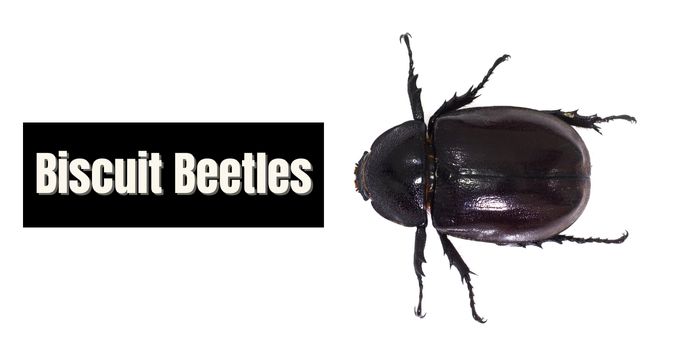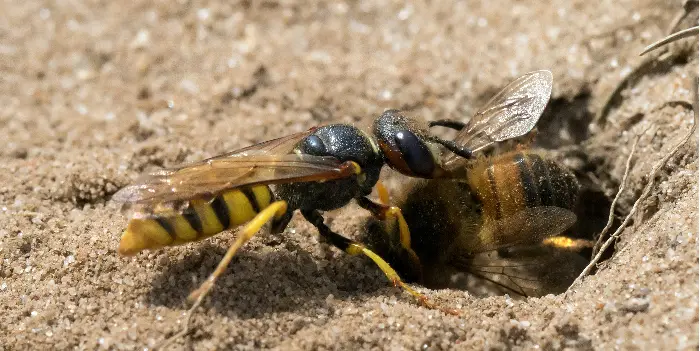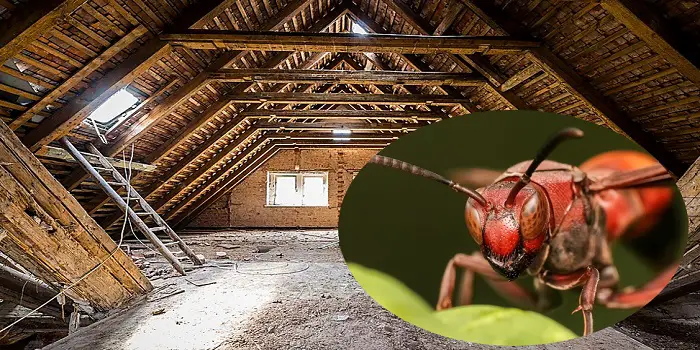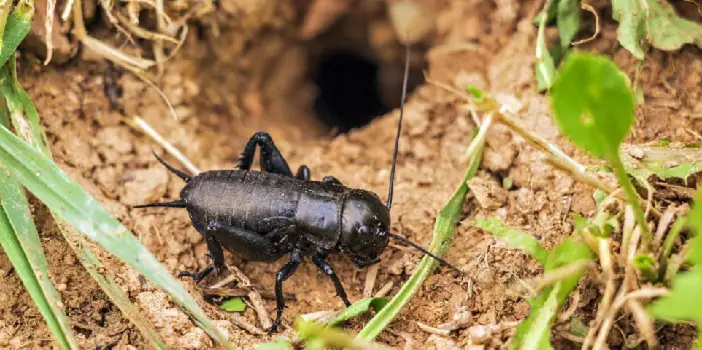
Although you might not check your dried food for pests often, it is necessary every once in a while.
Pests such as biscuit beetles (also known as drugstore beetles and bread beetle) can thrive in your store cupboards and contaminate food, which creates health risks.
This guide will teach you everything you need to know about biscuit beetles and answer some common questions about infestations.
What are Biscuit Beetles?
The biscuit beetle, or Stegobium Paniceum, is a small brown insect that measures 2.25 to 3.5 mm in length.
These beetles are typically small, hard-shelled, reddish-brown beetles with an oval-shaped body that is covered in short yellowish fine hairs.
They also have unique grooves on their wing covers – yes, they have wings, and they can fly.
They get their nickname from their love of eating biscuits, but they will also feast on cereal products, dried fruit, and spices.
They are often confused for the Common Furniture Beetle (woodworm) because of their physical similarities. If you think you have a biscuit beetle infestation, it’s best to get an expert opinion to make sure.
Life Cycle
Biscuit beetles go through the same four life stages as other beetle species – egg, larva, pupa, and adult.
Female biscuit beetles only lay between 75 to 100 eggs in their lifetime.
Biscuit beetles lay their eggs in dry organic detritus, where the larvae dig when they are preparing to pupate.
They deposit eggs in leather, hair, horn, wool, wooden things, and museum specimens.
White eggs are laid one by one over a span of 6 to 20 days and hatch into larvae anywhere from 26 to 100 days later, depending on external conditions such as weather or food availability.
Biscuit beetle larvae go through 4 to 6 stages, each one lasting four weeks at most. They spend 12 to 18 days in the pupal stage, during which time they’re inactive inside a cocoon made of food materials.
The pupal stage of biscuit beetles generally lasts 12-18 days. During this time, they are inactive inside a small cocoon formed from food materials.
Once they emerge as adults, however, they can fly and only live for another 16 to 20 days.
The life cycle of a biscuit beetle takes 2-7 months, depending on the food source and temperature.
Development can occur when the temperature is 60 to 93°F (-15 to 34°C), on average.
However, development can be optimal when the temperature reaches 85°F (-30°C), with 60 to 90% relative humidity.
What Do They Feed on?
Despite the fact that these tiny beetles aren’t picky eaters, they will consume whatever is available.
They are, however, focused on areas where food has been kept. They go for things like flour, pasta, grains, and – brace yourself – biscuits.
Many people wrongly believe that biscuit beetles only eat biscuits and drugs, when in reality, they’ll consume anything.
The exception to this is metal or cast iron, which Larvae also don’t munch on but can tunnel through for shelter while pupating.
Where Do They Live and Come From?
Biscuit beetles prefer mild climates and can be found in dark, warm, undisturbed locations near their food source, for example, behind your cupboard door on some old, seldom-used food that you’ve forgotten about.
There is no official record of where biscuit beetles originate from, but their pattern of destruction has been observed during the restoration of oil paintings from the 17th century.

Are Biscuit Beetles Harmful?
Now, this is the most important question. Are biscuit beetles dangerous, or can they harm humans or pets?
The short answer is no; they are not harmful to humans or animals. Since they do not sting or bite, even if you touch them barehanded, you’re not in any danger.
The only real threat biscuit beetles pose to your plant matter – is because they are herbivores and not carnivores.
Biscuit beetles are also not known to be vectors of any disease. Because they are not referred to as parasites, they do not live in pets or people.
As a result, adults and larvae are non-hazardous and should not be avoided.
All that said, they can cause extensive damage to property, food sources, and even historical artifacts.
While biscuit beetles aren’t dangerous to humans, their larvae can do some serious damage – they are known to be notorious pantry pests.
These voracious little eaters can quickly ruin food stores, as well as damage any organic material they come into contact with.
This includes things like furs, hides, wool, feathers, and even dried insects.
How to Get Rid of and Prevent Biscuit Beetles?
Remember, biscuit beetles will not go away on their own unless they become adults.
When larvae are preparing to pupate, they dig tunnels into the ground via the food source’s substrate.
They spend the whole pupal stage buried inside these layers and emerge as adults when they emerge. If there is a food shortage in an area, larvae will leave only if absolutely necessary.
So, how do you get rid of biscuit beetles?
The most important thing is to find and eliminate the source. This can be sometimes difficult, as they are often found in hard-to-reach places.
But once you have located the source, you can begin to get rid of them.
- To seal the insects in the infested food products, wrap them tightly in a plastic bag and dispose of them.
- You can also place infested goods in a pan and bring them to a boil for 16-24 hours or until they reach 190°F (87.8°C).
- Alternatively, infested items can be frozen for at least two weeks at 36°F (2.2°C) or for at least a week at 25°F (-3.8°C).
Besides the above, you can also use pheromone traps or sticky traps. Although they cannot kill or repel larvae, they can trap the males, destroying their reproductive cycle.
Biscuit Beetles Prevention Tips
If you want to keep biscuit beetles out of your home for good, you need to do more than just eliminate the ones that are already there.
You also have to take steps to prevent them from coming back. Here are a few things you can do:
a) Food packages
Make sure you only ever buy food packages that are sealed shut without any damage.
It’s also best to avoid buying large quantities of grains, pet food, and other dry goods, especially during summer when biscuit beetles are most active.
If you do need to add new stocks of dry foods, don’t mix them in with the old supplies. Put the new items in separate plastic, glass containers instead that can be tightly sealed.
b) Practise regular cleaning
Make sure no food scraps remain in the vicinity when practicing regular cleaning and vacuuming of storage places.
Because biscuit beetles feed on paper, you should do a thorough book inspection of your bookshelf, especially those you don’t read frequently.
Keep your leather shoes, jackets, and bags north within your closet when not in use.
c) Seal the small openings and entryways
To prevent adult biscuit beetles from getting inside, fix any damaged window screens and caulk up tiny cracks on walls.
Check the weather stripping around doors and make sure there are no gaps. Pay special attention to pet food storage areas to keep them airtight.
The Conclusion
Biscuit beetles are not dangerous to humans, but their larvae can cause extensive damage to food sources and any organic material they come into contact with.
To get rid of biscuit beetles, you need to find and eliminate the source.
Biscuit beetles can be treated in a similar way to other pantry pests, and the techniques for eliminating them are also comparable.
The greatest preventative action is to keep them out of your home in the first place.
Share the post "Biscuit Beetles – Information and Prevention Guide"

Welcome to ProShieldPest.com. I am Tina Jones. I have been working as a pest removal professional in Winslow, Arizona lately. At present, I love to spend my time with my family as a retiree.
Here I share all my knowledge and experiences to help people understand better how they can stop pests at their homes without actually killing them. Hopefully, the information you will find here will help in safeguarding your home! You can check more about me here.




